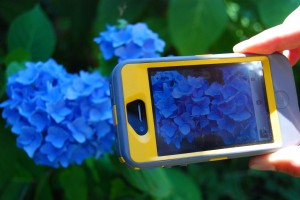
By Kristie Reddick and Jessica Honaker

It can be tough to get a young person to focus on the beauty of nature when you’re competing with HD moving images and games on computers, tablets and phones. Lately, we’ve been teaching outdoor workshops with live insects where we’ve had to say to a kid, “Look with your eyes, not with your iPhone.”
It’s a hard line for us to walk, because as The Bug Chicks (http://thebugchicks.com) we produce videos for a wide range of educational institutions as well as our own WebTV channel. Here’s a video we produced for the US Forest Service about flowers attracting pollinators:
Technology is fun and flashy, and integrating it with the outdoors can be a challenge. So, if you’ve got a child who wants to play on the computer all day, and you want them outside learning about nature, this post is for you. By inspiring your kids to make their own nature documentaries you can blend mobile technology, a little research and nature into a fun outdoor activity. Plus you get a video to share with your extended family on Facebook!
#1: PICK A TOPIC
Sounds like a no brainer, but picking a specific topic can help this project move from daunting to doable.
- Familiar is good. Like to hike a certain trail? Pick three or four things you know you’ll see or hear during a hike to focus your video on. (Bumblebees, sword ferns, robins)
- Pick something doable. There are no grizzlies in Portland. And even if there were, are you going to film near them? Probably not. Bugs are a great choice because they are everywhere!
- Family Production crew. Plan your topics so that everyone can be on camera talking about something they like and also helping to film and direct others.
* Tip: Let your children’s interests lead the way. If they are interested in finding the mushroom that looks like the one in their video game, go for it! You never know if this exercise will lead to a career in mycology.
#2: RESEARCH
This is the part that’s going to feel the most like a chore, but if you’re clever about how you approach it, it won’t have to.
- Delineate who will talk about what on camera. Each person is responsible for that part of the research.
- Do you have a tablet that you let the kids use as a reward? Spend five minutes and download a nature app that can help them with their research. Now it’s fun! (The Audobon Society had some incredible apps for all devices.)
- Pick websites with solid information! Usually, it’s best to stick to university, government and trusted organizational sites, but there are also many good blogs out there. This is a great exercise in digital literacy for your kids.
#3: SCRIPT
Some people need a script and others don’t. For kids, an outline might be a good compromise. This will help them develop extemporaneous speaking skills and fact memory while helping to keep their topic organized.
- Keep it loose. Kids talk in a different way so we should let them! Have them describe what the shape, color or smell reminds them of. This is great ‘blooper reel’ material.
- Have a clear beginning, middle and end. But realize that flexibility counts. If a new idea comes up that everyone likes, go with it!
- Keep it short. Hit three facts about each animal or plant.
Insert Picture Here: iPhone Filming
#4: FILM IT
If you spend too much time planning, people lose interest. The filming is the fun part!
- Equipment doesn’t matter. It’s how you use it! Use a phone, or the video setting on your camera. Do a test shot and play it back to make sure the sound is good and you’re golden. If you stand too far away, your sound will suffer.
- Keep it steady. Prop the camera on a bag or a shoulder to be still while filming
- Get traveling and scene shots. These will enhance the video and provide a sense of place.
- Keep it simple. Don’t try to do too much in a shot until you’re comfortable. For example, walking, talking and bug wrangling is HARD. Sit down and it will be easier!
* TIP: If you’ve found your animal that you’d like to film, film it first! This way you can have footage of it! If we catch an insect to talk about we always get a close-up shot first and talk while the camera is on the bug. The camera can come back to our faces AFTER we’ve filmed the bug in our hand.
#5: MAKE YOUR MOVIE
This is the other fun part! Editing a movie together can be a great rainy day activity or after dinner exercise. Go back to your script to think about how to piece it together.
- Editing Software- On a Mac it doesn’t get easier than iMovie. On a PC try out Movie Maker. If you’re looking for a great, easy way to film and edit, try a Flipcam. It’s got one button recording, and it plugs right into a computer via a USB. When you plug it in, there’s editing software that will automatically open with step-by-step instructions on how to create your movie.
- Finishing touches make it awesome. Put music underneath it and don’t forget credits and titles!
This project may seem daunting, and it’s not going to come together overnight. But you can easily have a cool, nature video created by your family by the end of the summer. We know people who do one a day! Once you get the hang of it, there’s no stopping your creativity.
Bug Chicks Bio:
Kristie Reddick and Jessica Honaker are entomologists who love to teach about insects and other arthropods. After receiving their Masters degrees in Entomology from Texas A&M University, they created The Bug Chicks, an online entomological adventure featuring a WebTV series and a popular blog. They blend science, art, journalism and video production to inspire people young and old to learn about arthropods. For more information, free videos and podcasts go to: www.thebugchicks.com.



2 thoughts on “Lights, Cameras, Bugs: How to get your family into nature using mobile technology”
Comments are closed.